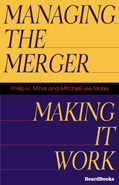|
|
|
|
||||||

|
Managing the Merger: Making It Work
By Philip H. Mirvis and Mitchell Lee Marks 2003/01 - Beard Books 1587981661 - Paperback - Reprint - 400 pp. US$34.95 Business managers and chief executives will find the insights, attitudes, and practical measures necessary to make a merger successful whether friendly or unfriendly, large or small. Publisher Comments In this groundbreaking book, first published in 1992, two veteran merger and acquisition mavens take you behind the scenes, examining dozens of successful as well as poorly managed corporate marriages, to show you what's really required to achieve the best possible strategic, organizational, and cultural fit between any two companies. They point out that the key to success is how the merger is managed and what steps should be taken before, during, and after the merger. The authors' broad experience in the field provides you with today's best practices in banking, health care, high tech, transportation, and many more industries. Referring to an earlier version: Here is step-by-step guidance on handling the most difficult aspect of a merger--the human side. Mirvis and Marks draw on their extensive work as consultants to 20 of the biggest mergers in the past decade to present key lessons for managing the merger. Illustrated. Referring to an earlier version: Statistics show one in every three acquisitions is sold off within five years. Why? In the final analysis it usually comes down to this: poor planning and management. Using in-depth case studies such as the corporate marriage of Sperry and Burroughs and Times Mirror's takeover of Graphic Controls, Managing the Merger gets into the guts of what it takes to make a merger work. It distills key lessons for successfully managing the human, organizational, and cultural differences that can unravel a seemingly "perfect fit." The great majority of corporate mergers and acquisitions fail, whether the yardstick used is combined earnings, sales, growth rates, or shareholder value. And the single most crucial factor in so many cases is how the merger was managed. In this groundbreaking book, two veteran M&A consultants take you behind the scenes -- examining the creation of Unisys, Times Mirror's acquisition of Graphic Controls, and dozens of other successful and poorly managed corporate marriages -- to show you what's really required to achieve the best possible strategic, organizational, and cultural fit between any two companies. With a growing number of strategic and global mergers looming in the 1990s -- including Japanese purchases of American firms and U.S. buys in Europe -- there is even a greater need, say the authors, "for joint planning, effective leadership, cultural sensitivity, and people-mindedness, central messages of this books.' From Martin Sikora, Editor, Mergers and Acquisitions A long overdue reminder to the numbers crunchers and bean counters that flesh and blood humans make the difference whether a merger succeeds or fails. It shows the dealmaker what to do with its people and, more important, what not to do to them. From Charles Garfield, author of Peak Performers: The New Heroes of American Business I know of now other book which backs up sound advice for merger managers with colorful examples of how the work of putting companies together really gets done. Mirvis and Marks cover both the hard business decisions of determining integration strategies and the delicate human and cultural dynamics which effect the implementation of every deal." From Isay Stemp, President, Stemp and Company Managing the Merger is by far the best book I've read about what to do and what not to do after the ink dries on the merger agreement. This book if full of no-nonsense observations about how to succeed in the critical area -- people. From Michael R. Losey, President, Society for Human Resource Management Merger management will be required competency of the most senior management for a long time to come, and this excellent summary of lessons learned to date should be studied by the next CEO faced with a merger. From Edward E. Lawler, Director, Center for Effective Organizations, Graduate School of Business Administration, University of Southern California Must reading for anyone interested in mergers and organizations. A rich and itneresting treatment of an important topic From Amazon.Com The authors' broad personal experience and intimate knowledge of the mergers and acquisitions field give you access to today's best practices in banking, health care, high tech, transportation, media/broadcasting, brewing, oil and many more industries.
The authors were dubbed "Merger Mavens" by Fortune Magazine.
|
|
|
|
home
| about
us | contact
us | related
sites |